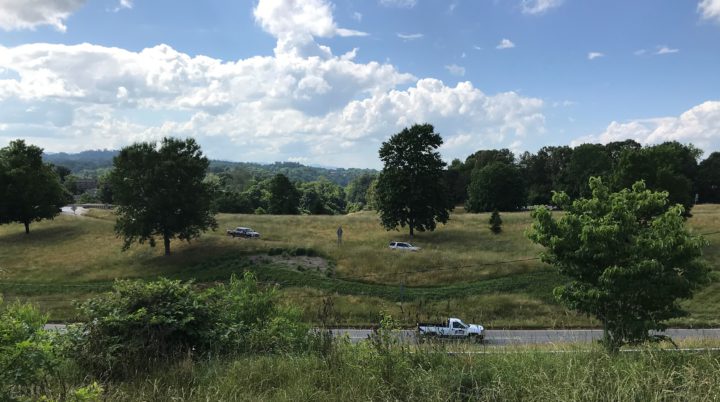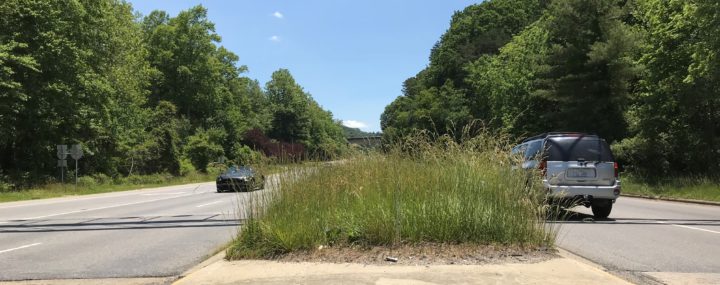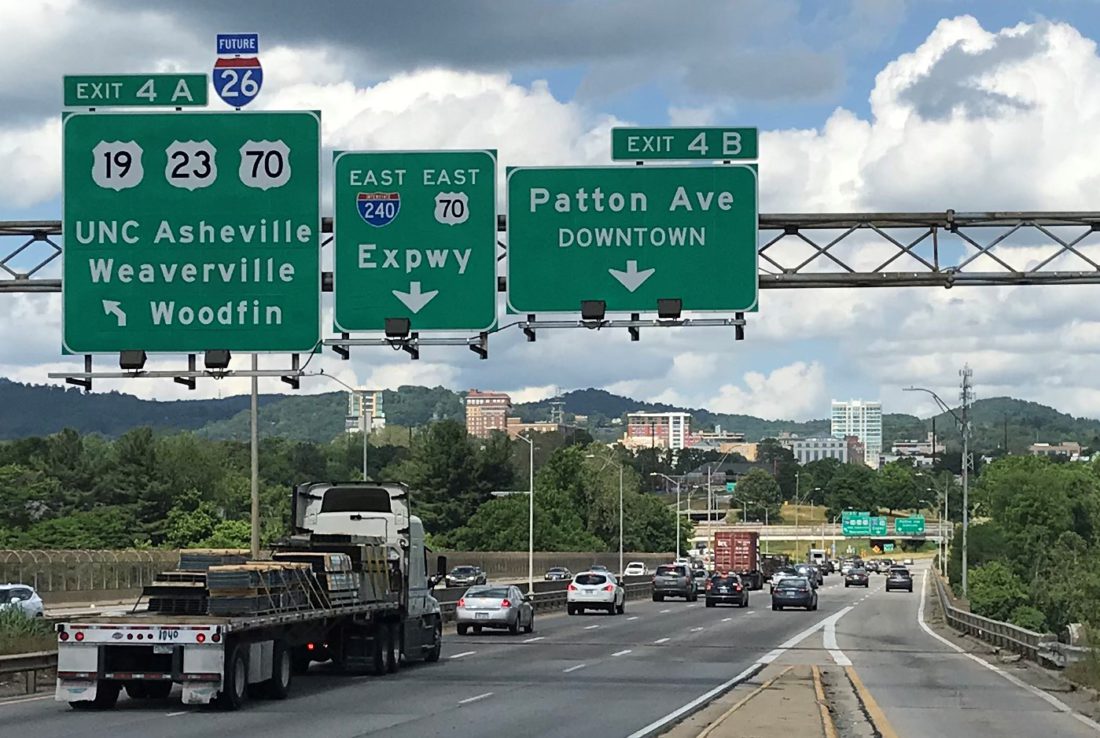Financial problems that have forced the N.C. Department of Transportation to furlough employees, put off construction projects and leave roadsides to grow up like hayfields this spring have not affected the schedule for what will be the Asheville area’s biggest public works project in at least a generation, the I-26 Connector.
Yet.
DOT plans to award a contract about this time next year to build the first part of the connector, a new crossing of the French Broad River north of Bowen Bridge and a freeway to connect the crossing bridges to Interstate 240 near where I-240 and Patton Avenue intersect in West Asheville.
The agency plans to award another contract in 2022 to widen I-240 to six lanes in West Asheville; a third contract is to be signed in 2025 for changes to the Interstate 26/Interstate 40/I-240 interchanges on the western edge of the city. DOT estimates the total cost at $950 million.
But revenue shortfalls caused by the COVID-19 pandemic and previous spending overruns due to natural disasters and what the state auditor says are lax financial controls within DOT have already prompted the agency to delay dozens of construction projects.
Might the I-26 Connector be next?
“That’s kind of one of those million-dollar questions,” says Steve Cannon, project development engineer for DOT’s Asheville-based Division 13. “It really depends on how the revenues play out.”
Two cash crunches
The connector has been discussed since the late 1980s and was included by the state General Assembly in 1989 on a list of highway projects to be funded partly by increases in the state’s taxes on gas and vehicle sales. Local opposition and consideration of alternatives have slowed the project at times. Money problems — the cost of promised highway projects was far greater than DOT could afford to build — have delayed the process at other points.
Financial issues are back, with a vengeance. State Auditor Beth Wood’s office released a report last month saying DOT exceeded its $5.9 billion spending target for the 2018-19 fiscal year by $742 million, a 12.5% overrun.
Part of the problem is that DOT had inadequate controls over spending by its 14 division offices around the state and in general did not monitor its spending as it should, the report found. Other factors the report cited are inadequate budgeting for natural disasters and a reduction in general maintenance funding imposed by the legislature that pegged that part of DOT’s budget back to roughly where it was in 1992-93.
DOT budgeted $50 million a year for storm recovery for the 2015 through 2019 fiscal years. But North Carolina has been especially hard hit by hurricanes and flooding in recent years, meaning that amount was typically only about half what was needed. And, a few years ago, the General Assembly pressured DOT to spend down what legislators considered to be excess cash reserves the agency was holding. It did.
DOT’s money problems began getting more attention last year and then-Transportation Secretary Jim Trogdon stepped down in February. Now legislators are looking for ways to shore up DOT finances.
The previous issues combined left DOT especially unprepared when COVID-19 hit and people cut back on driving and buying cars. Receipts from the gas tax, DOT’s largest single source of revenue, were off about 20% in April. Proceeds from the state’s highway user tax, a 3% tax on auto sales, declined 27%.
Revenues from both taxes decline when economic conditions are poor, as people drive less and hold onto their current vehicles longer, so it is possible shortfalls will continue for some time to come.
Add it all up, State Treasurer Dale Folwell told a legislative committee recently, and DOT has “maxed out their credit card for the next 10 years.”
On track for now
William “Billy” Clarke, a Buncombe County attorney who represents Division 13 on the state Board of Transportation, says he can’t predict what DOT’s financial troubles will mean for the connector. The division takes in Buncombe, Burke, Madison, McDowell, Mitchell, Rutherford and Yancey counties.
Clarke does expect that as climate change contributes to more extreme weather events, the agency’s cost of responding to storms is unlikely to fall.

Julie Mayfield, who as an Asheville City Council member and head of an environmental group has pushed DOT to change connector plans to accommodate local criticisms, says DOT “is working very hard to keep this project on track. It’s clearly their priority project for this region, and they want to see it done.”
A clear indication of whether the first part of the project will move ahead on the current schedule will come around the end of the year, when DOT is scheduled to issue a request for proposals ahead of bidding on the construction contract to be awarded in summer 2021, she says. That can’t happen if DOT does not have the financial reserves required by state law, Mayfield adds.
Mayfield and other city residents have pushed for a smaller footprint for the connector, including keeping I-240 at four lanes in West Asheville instead of the six now planned and consolidating the spaghetti bowl of interchange ramps just east of Bowen Bridge to free up DOT property for redevelopment. They also have sought to have only two lanes of vehicle traffic on Bowen Bridge in each direction — through traffic will use the new crossing of the French Broad — with the remaining space to be used for pedestrian and bicycle paths and landscaping.
With a couple of notable exceptions, “DOT has essentially given us everything that we wanted,” she says. There is tentative agreement on a design for the interchange near the downtown end of Bowen Bridge that will both open up space and allow bridges and a wall next to Riverside Cemetery to be lower than previously planned, she says, and DOT has bought into the idea of a four-lane Bowen Bridge.
Mayfield says she would still prefer a narrower stretch of I-240 in West Asheville, particularly where Haywood Road crosses the freeway, but DOT says its traffic standards mean it won’t budge on that issue. Advocates of changes have won about all of the modifications they can expect to get, she says.
A murky crystal ball
DOT might move ahead with work on a new route across the French Broad as scheduled but later have to postpone work on I-240 in West Asheville and the I-26/I-40/I-240 interchange. Contracts for those parts of the project are to be awarded in 2022 and 2025, respectively.
Cannon acknowledges that as DOT delays projects scheduled to begin over the next year or two, a resulting domino effect could cause postponement of future work like the other two sections of the connector. DOT has already delayed planned construction dates on several smaller projects in Buncombe County like changes to part of Merrimon Avenue in North Asheville and a greenway along Hominy Creek in the Enka-Candler area.
The biggest shift so far affects plans to widen U.S. 19-23 to either six or eight lanes between Broadway and Exit 23, near Reynolds Village in Woodfin. Work on the $151 million project had been scheduled to begin in 2024, but that date has been pushed back to 2027.

DOT has taken several other steps to conserve cash this year. In addition to cutting employee work hours via furloughs, Division 13 has suspended its landscaping and wildflower planting programs and cut maintenance to “safety-related” work only, “things like patching potholes, clearing sight distances, things that could create a safety issue for the traveling public,” Division Engineer Mark Gibbs said. Grass mowing only began June 1, and the number of times roadsides will be mowed will drop from the usual five to just three.
Plenty of decisions still lie ahead for the I-26 Connector. A city-appointed committee of local residents charged with looking for ways to make the highway more attractive has identified steps the city could take that would cost as much as $9.8 million. If work stays on track, City Council will have to decide in the next few months which of those city government will approve and pay for.
DOT will start buying land for the first phase of the project, the French Broad crossing, about the same time the construction contract for it is awarded, Cannon says. That and the other connector contracts are what DOT calls design-build contracts, meaning the construction companies will do final design work after their bids are accepted. A key question they and DOT will tackle is the location of noise reduction walls.
Physical construction will probably begin 12-18 months after contracts are signed, Cannon says. He notes that DOT is working on the assumption that a contract will be awarded next summer as scheduled, but he and Gibbs say it is too soon to predict whether the connector could be affected by any additional cost-cutting steps.
“What our folks in Raleigh are telling us is every option remains on the table,” Gibbs says.




NCDOT represents the last vestiges of our decaying energy glutton society. More roads and widened roads are not the future of our society; but the monied interests are so pervasive that no one can alter the course direction.
To think the NCDOT could overrun their budget to such a degree and only get a slap on the wrist tells you how much power they wield in the state. That power is all in the form of money and big contracts and lots of back room back slapping with the good old boys around the state.
It would not surprise me that the connector gets started but never gets finished. It will be a monument to our foolish ways. America is falling apart. Economically, we’re living on borrowed time; have been for some while. Printing money at the Fed and borrowing trillions in DC is all that has been keeping us out of a greater Depression. Even those things will not succeed at some point; probably sooner than later.
Six years ago, then-Rep. Tim Moffitt advocated for privatized toll “Lexus lanes” to pay for I-26 expansion. Does anyone doubt he’ll do the same this time ’round? Vote Blue!!!
https://mountainx.com/news/statehouse-candidates-debate-turner-vs-moffitt/#comment-2063756